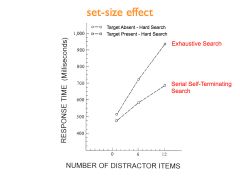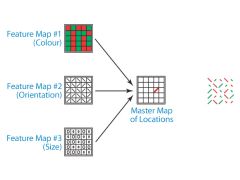![]()
![]()
![]()
Use LEFT and RIGHT arrow keys to navigate between flashcards;
Use UP and DOWN arrow keys to flip the card;
H to show hint;
A reads text to speech;
27 Cards in this Set
- Front
- Back
- 3rd side (hint)
|
Neisser visual search task |
involved searching for a certain target positioned in arrays of non-targets |

|
|
|
Distractor |
non-targets that surround the target, making it difficult to find the target |
|
|
|
Pop out |
when target is sufficiently different from the distractors, the targets presence or absence is immediately apparent |
|
|
|
Preattentive stage (visual search) |
early stage of visual search processing proposed by Neisser enables almost immediate target detection without the need for effortful, serial inspection |
|
|
|
Late stage (visual search) |
second stage of visual search processing proposed by Neisser slower search stage, involving alignments of focused attn to different items in the search array in order to locate target |
|
|
|
How did Neisser explain "pop out"? |
suggested targets may "pop out" because preattentive processing is carried out in parallel on all search display items at the same time. no need for serial search. |
|
|
|
what is the strongest "pop out" feature? |
colour |
|
|
|
odd-man-out task |
task that involves detecting what is different/ boundaries of where things change
|

|
|
|
set-size effect |
the effect the number of distractors has on response times vary with set size. easy search: doesnt matter how many distractors or if target is present hard search: greater effect when more distractors and present, and even greater when target is absent. |

|
|
|
Why does it take longer to determine if a target is absent in a hard trial? |
need to check entire set before being sure it is not there. unlike if it is present, you stop when you find it |
|
|
|
texture segregation |
process of determining boundaries between regions of objects with different shape, orientation, size, etc. |
|
|
|
exhaustive search |
serial inspection of entire array occurs on target-absent trial |
|
|
|
Serial self- terminating search |
serial inspection of array terminated when target found |
|
|
|
serial vs. parallel search |
serial: on at a time parallel: all at once |
|
|
|
Feature-integration theory |
Proposal by Treisman and Gelade (1980) about the processing that mediates visual search and object perception. based on the interactions of feature maps and a master map of locations. When target pops out, presence signalled by feature map. When target found effortfully, each item in display inspected in sequence . involved in accessing info from feature modules to verify targets features. |

|
|
|
Illusory Conjunctions |
Features are "free floating" until glued together by attn. when shown objects of different shapes and colours, subject would report seeing an object of colour that wasnt there. colour of neighbouring shape blends together. why? - happens because attn overloaded. didnt have time to "glue" feature shape and colour |
|
|
|
split-brain visual search |
found that they have attn system in each of their hemispheres |

|
|
|
feature map vs master map |
there are a number of feature maps that provide input to a common master map feature maps correspond to different properties of an object (ie. colour, orientation, motion) |
|
|
|
describe the process of visual search using the feature-integration theory |
1.when target with a unique feature target pops-out, its location is registered within the feature map in question. this map provides signal that allows focused attn to be directed to same location within master map, observer immediately detects target. 2. when target not unique, focused attn directed in serial manner to each of a number of master map locations.. when attn focused at particular location, provides info at corresponding location in each of the feature maps. features of item integrated. |
|
|
|
what were some exceptions to the feature-integration theory? |
cannot account for why some targets can be detected rapidly, even when they don't possess unique features |
|
|
|
guided search |
Feature maps send signals to the master map about where NOT to look |
|
|
|
abrupt-onset targets |
appear suddenly within the visual search array after the distractor items were physically presented capture attn in a stimulus driven manner |
|
|
|
gradual-onset targets |
initially presented stimuli with additional "irrelevant" lines serving as camouflage. as trial proceeded, camouflage would be removed to reveal target allows precise control of timing of onset |
|
|
|
contingent attentional capture |
hypothesis that attentional capture is necessarily goal-driven. although there is a debate about that. |
|
|
|
level-readiness effect |
suggests there is no default setting for the spatial extent of attentional focus and that it may remain at its current setting until an adjustment is required to perform a new analysis |
|
|
|
object- based processing |
attentional processing is limited to a restricted number of objects |
|
|
|
space-based processing |
attentional processing is limited to a fixed part of space |
|

